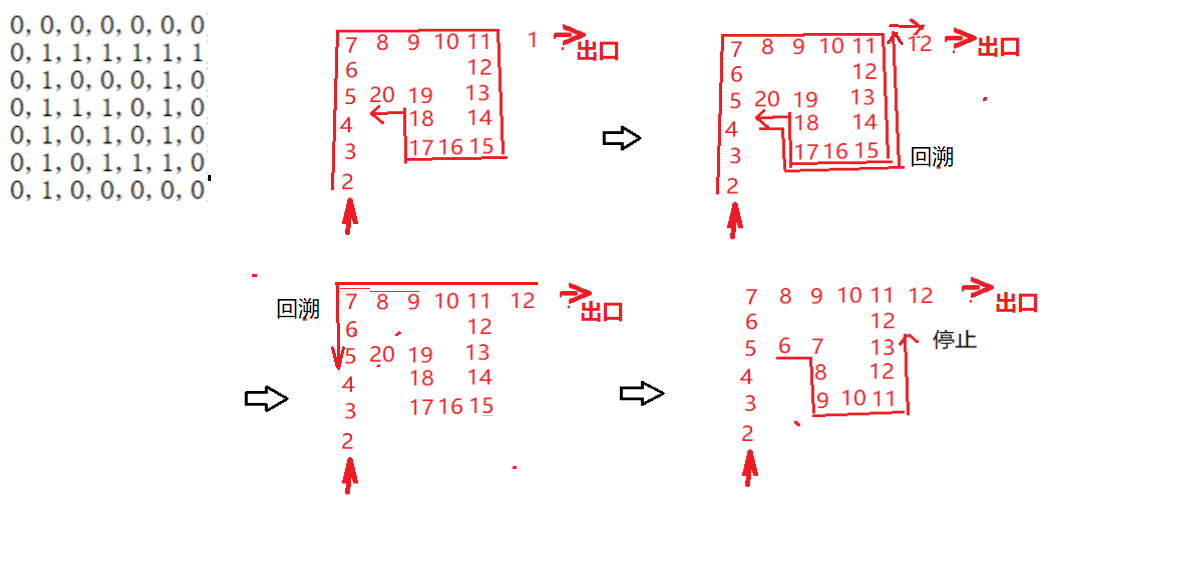我们大家在小时候可能都玩过 “找路线”、“逃出迷宫” 这样的小游戏。通常的玩法一般是一开始顺着入口往后面走,遇到岔路口,就选择其中一条路往后走,走到此路无路可走的时候 ,就再退回到岔路口,然后再去选另外的一条路走,每次走到此条路不通时就返回到上一个岔路口另选一条路走 ......经历这般 “摸爬滚打”之后,最后才可能走到出口。容易想到以同样的思路递归实现迷宫问题。
首先,还是先来做准备工作,定义一个全局的二维数组表示迷宫、一个结构体变量表示坐标,如下
简单的迷宫(没有回路)
如下:

用递归的思路,容易想到 :从入口点开始,在与它相邻各个方向中找出一可通的位置,然后跳至该处并把此位置的值置为2,然后重复以上操作,划分子问题,当最后到达规定的出口时停止算法。
代码如下:

1 #pragma once
2 #include <string.h>
3 #define N 7
4 int maze[N][N]={
5 {0,0,0,0,0,0,0},
6 {0,1,1,1,1,0,0},
7 {0,1,0,0,0,0,0},
8 {0,1,0,0,0,0,0},
9 {0,1,1,1,1,0,0},
10 {0,1,0,0,1,1,1},
11 {0,1,0,0,0,0,0},
12 };
13 typedef struct Pos
14 {
15 int _col;
16 int _row;
17 }Pos;
18
19 void PrintMaze(int arr[][N])
20 {
21 assert(arr);
22
23 for(size_t i = 0; i< N; ++i)
24 {
25 for(size_t j = 0; j < N; ++j)
26 printf("%2d ", maze[i][j]);
27 printf("
");
28 }
29 printf("
");
30 }
31 int IsAccess(Pos cur, Pos next)
32 {
33 if(maze[next._row][next._col] == 1
34 && 0<= next._row && next._row < N
35 && 0<= next._col && next._col < N)
36 {
37 return 1;
38 }
39 return 0;
40 }
41 void GetPath(Pos cur)
42 {
43 Pos next = cur;
44 if(cur._col == N -1) //找到出口
45 {
46 printf("出口:<%d, %d>
", cur._row, cur._col);
47 //return ;
48 }
49 maze[cur._row][cur._col] = 2;
50 //向右走
51 next = cur;
52 next._col+= 1;
53 if(IsAccess(cur, next))
54 GetPath(next);
55 //向上走
56 next = cur;
57 next._row-= 1;
58 if(IsAccess(cur, next))
59 GetPath(next);
60 //向下
61 next = cur;
62 next._row+= 1;
63 if(IsAccess(cur, next))
64 GetPath(next);
65 //向左
66 next = cur;
67 next._col-= 1;
68 if(IsAccess(cur, next))
69 GetPath(next);
70
71 }
上面代码可以找出可通的路线,但是对于有多条路线的迷宫,此种方式不能找出一条最短的那条路线,并不理想。
继续往下优化 ~_~ ...
带环的多条线路迷宫,选择路径最短的一条线路

有一种比较巧妙的办法:改变记录迷宫线路的方式来实现。
思路:改变记录走过位置的标记方式。当前坐标位置的标记值是上一个位置的标记值加1
得到;(假如某个位置走过了,被标记为了4,那么走过的下一个位置就将其标记为5... )
与此同时,这样的记录方式还有一好处就是间接的表示了一条路径的长度。
由于改变了标记的方式,判断下个位置是否可通的条件做相应改变
判断可通条件:当前坐标的标记值 < 下一个坐标处的标记值 或者 下一个坐标标记值为 1
注意: 由于标记为 1的坐标也表示可通,所以初始时入口处坐标不妨从2开始标记。
实现代码:

1 #include "Stack.h" //上次实现的栈头文件
2
3 int IsAccessInShortPath(Pos cur, Pos next)
4 {
5 if(( maze[cur._row][cur._col] < maze[next._row][next._col] || maze[next._row][next._col] == 1)
6 && 0<= next._row && next._row < N
7 && 0<= next._col && next._col < N )
8 {
9 return 1;
10 }
11 return 0;
12 }
13 Stack shortPath;
14 void GetShortPath(Pos cur, Stack* pPath)
15 {
16 Pos next = cur;
17 if(StackEmpty(pPath) == 0) //初始入口位置 记为2
18 maze[cur._row][cur._col] = 2;
19 else
20 {
21 Pos prev = StackTop(pPath); //当前位置标记值 为上一个位置标记值+1
22 maze[cur._row][cur._col] = maze[prev._row][prev._col] + 1;
23 }
24 StackPush(pPath, cur);
25 if(cur._col == N -1) //找到出口
26 {
27 printf("出口:<%d, %d>
", cur._row, cur._col);
28 //每找到一条路线就和shortPath里的路线比较长短
29 //找到的路线更短,刷新shortPath
30 if(StackSize(pPath) < StackSize(&shortPath)
31 || StackEmpty(&shortPath) == 0) //初始shortPath为空,需要刷新。
32 {
33 //不能直接shortPath._array = pPath->_array这样赋值
34 //shortPath._array = pPath->_array;
35 //shortPath._end = pPath->_top;
36 //shortPath._top = pPath->_top;
37
38 if(shortPath._array)//刷新shortPath,由于每次额外开辟空间来保存较短路径
39 free(shortPath._array); //需要释放上一次开辟空间
40 shortPath._array = (DataType*)malloc(sizeof(DataType)* pPath->_top);
41 memcpy(shortPath._array, pPath->_array, sizeof(DataType) * pPath->_top);
42 shortPath._end = pPath->_top;
43 shortPath._top = pPath->_top;
44 }
45 }
46 //向上走
47 next = cur;
48 next._row-= 1;
49 if(IsAccessInShortPath(cur, next))
50 GetShortPath(next, pPath);
51 //向下
52 next = cur;
53 next._row+= 1;
54 if(IsAccessInShortPath(cur, next))
55 GetShortPath(next, pPath);
56 //左
57 next = cur;
58 next._col-= 1;
59 if(IsAccessInShortPath(cur, next))
60 GetShortPath(next, pPath);
61 //右
62 next = cur;
63 next._col+= 1;
64 if(IsAccessInShortPath(cur, next))
65 GetShortPath(next, pPath);
66 //四个方向都走不通 开始回朔,pop掉path栈里保存的路径坐标
67 StackPop(pPath);
68 }
递归的过程可参考下图:

最后再简单测一下:
void TestMaze() { Pos entry; entry._col = 1; entry._row = 6; /*GetPath(entry); PrintMaze(maze);*/ Stack path; StackInit(&path); StackInit(&shortPath); GetShortPath(entry, &path); PrintMaze(maze); while(StackEmpty(&shortPath) != 0) { Pos cur = StackTop(&shortPath); printf("(%d,%d)<-", cur._row, cur._col); StackPop(&shortPath); } printf("入口 "); }
结果:
小结一下:
1.刷新shortPath里保存的路径,需要将path栈里存的路径整体拷贝过来。若将实现path栈底层的_array直接赋值给shortPath._array:
以本迷宫为例,它会先找到 ‘厂’ 型的路线,于是shortPath._array被赋值为path->_array,以此来保存路径;而在找第二条路径时 当递归到<4, 5>处递归结束,说明这条路径更长 shortPath._array存放的内容应保持不变(即上一条路径),但在回溯查找该条路经时,shortPath有出栈操作,shortPath._array里内容会被改动; 而若是整体拷贝的话,每次都是新开辟空间来保持短路径,如若没到规定出口处,shortPath._array不会刷新,一直保存是一条最短的路径。
2.实现该迷宫时,默认设置出口为col = 6的位置,其实应该将出口的信息作为参数传入找路径的函数中,大家可以自行再优化。

